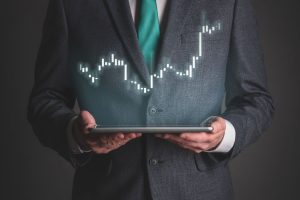
It’s that time of year, folks.
When December rolls around, the predictions for the coming year roll out at a fast and furious pace.
The S&P 500 has notched 20%-plus returns in the past two years – a truly remarkable run – and the consensus is that 2025 will be another gangbuster one for stocks. Analysts are virtually unanimous in believing the S&P 500 will deliver positive returns – and above-average ones at that.
For example…
- Goldman Sachs predicts that the S&P will finish 2025 at 6,500.
- Deutsche Bank: 7,000.
- Yardeni Research: 7,000.
Analysts at Wells Fargo set the high-water mark on Tuesday, issuing a forecast of 7,007.
Yahoo Finance has been tracking these predictions, and so far, we’re looking at a range of 6,400 to 7,007. That’s 5% to 15% upside from current levels.
The reason why there’s a range is because these folks use all sorts of methods to arrive at those numbers. One analyst might be a “macro” expert who tracks geopolitical developments and economic conditions. Another may be a “quant” (like myself) – specializing in algorithmic or statistical models that combine historical data with current valuations, earnings projections, etc.
Others may rely on technical analysis… sentiment… discounted cash flow models… or a combination of all of the above.
Here’s the reality, though. None of these folks have a crystal ball. And if they did, they certainly wouldn’t let us look at it…
The truth is that these folks are just trying to come up with their best guess with the information at hand.
These different methods analysts use reminds me of what the Ancient Greeks used to do. They would often consult various sages and mystics for signs about the future. And they took it pretty seriously, looking for signs and omens related to matters of war, politics, love… you name it.
What they watched for varied somewhat. The Romans liked to interpret the eating habits of sacred chickens before battle. Others would examine the entrails of sacrificed animals.
One such practice was called auspicy, and it usually involved interpreting the signs of birds.
Case in point: The Battle of Marathon in 490 BC.
According to some accounts, the Greek generals sought guidance from a seer (or Auspex), who interpreted the flight of the birds in the sky to predict the outcome of the battle. If the interpretation was favorable, it was considered a divine endorsement.
(This is also where we get the phrase “under the auspices” – meaning under the protection or with the support of a higher authority.)
Whatever they did apparently didn’t hurt that day because the battle was a famous victory. Plus, it was great for morale – and that can mean a lot when the stakes are high.
Now, we don’t know exactly what kind of bird the Auspex used that day. One practitioner might interpret the flight path of a raven. Another might use crows.
My point is we’ve been trying to make sense of an unpredictable world for thousands of years. Whether through divine guidance or complicated algorithms, the intention is still the same.
The “Divine” Nature of Stock Grader
This even applies to Stock Grader, my proprietary quantitative stock-picking system.
Here’s how it works…
Every public company has hundreds of data points (often called “factors”) related to its business and its stock.
This means you can analyze trillions upon trillions of factor combinations in order to find the most effective stock selection strategy.
This, of course, requires a lot of computing power. But thanks to the extraordinary technological advances of the past few years, that type of power is at our fingertips.
In my over 40 years of experience and research, I’ve found that when a unique set of nine “metrics” come together in a certain way in one stock, it portends enormous short-term stock market gains: eight fundamental metrics and one quantitative buying metric.
This is my “secret sauce” to some of the big wins I’ve had over the years.
It’s how I made over 700% on an online discount retailer in China called Vipshop Holdings Ltd. (VIPS) a few years ago.
It’s also led me to current winners in my Growth Investor service, like NVIDIA Corporation (NVDA) – where we’re sitting on a gain of 3,200%!
So, you could say that using Stock Grader is like doing a little stock market divination, if you will. Except we’re talking about a massive, computerized research project, which, over the years, has cost millions of dollars.
The Quant System for Big Gains in 30-60 Days
Now, I use Stock Grader to find long-term winners. But if you’re looking for a quant system that finds big gains in the short term, then I’ve got some exciting news for you: My friend and InvestorPlace colleague Luke Lango has created a unique quant system that does just that.
Luke calls this system Auspex.
He has spent nearly a year building and testing a powerful new screener to help readers find the best stocks at the best time. Auspex blends different fundamental, sentiment and technical factors to find stocks that can hand you long-term gains in short-term holding periods.
In fact, Luke’s Auspex portfolio just delivered another stellar performance in November, outpacing the S&P 500 for the fifth consecutive month. What’s more, a thorough backtest showed it would’ve done 18.6X better than the stock market from April 2019 to April 2024.
And Luke is finally ready to share this portfolio with the public.
The fact is that Auspex does the heavy lifting for you. With exposure to only 10 equities at a time, you can follow along with just about 10 minutes of work a month.
You’re going to hear more from Luke in a Market 360 later this week. In the meantime, if you’d like to learn more about Luke’s new Auspex system, you need to sign up for his Auspex Anomaly Event on Wednesday, December 11 at 1 p.m. ET. That’s when Luke is going to reveal more about Auspex, including an anomaly it’s discovered in the market that could hand you triple-digit gains in just 30 to 60 days.
Click here to reserve your spot now.
Sincerely,

Louis Navellier
Editor, Market360
The Editor hereby discloses that as of the date of this email, the Editor, directly or indirectly, owns the following securities that are the subject of the commentary, analysis, opinions, advice, or recommendations in, or which are otherwise mentioned in, the essay set forth below:
NVIDIA Corporation (NVDA)





